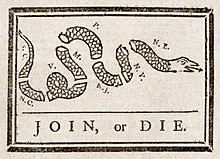 A New York City statue of Benjamin Franklin holding a copy of The Pennsylvania Gazette | |
| Founder(s) | Samuel Keimer Benjamin Franklin in 1729, who bought and reoriented the publication into a 'news only' newspaper |
|---|---|
| Founded | 1728 (as The Universal Instructor in all Arts and Sciences: and Pennsylvania Gazette) |
| Political alignment | Non partisan |
| Ceased publication | 1800 |
| Headquarters | Philadelphia, Pennsylvania, U.S. |
The Pennsylvania Gazette was one of the United States' most prominent newspapers from 1728 until 1800. In the years leading up to the American Revolution, the newspaper served as a voice for colonial opposition to British colonial rule, especially to the Stamp Act and the Townshend Acts. The newspaper was headquartered in Philadelphia.


The newspaper was first published in 1728 by Samuel Keimer and was the second newspaper to be published in the colonial Province of Pennsylvania under the name The Universal Instructor in all Arts and Sciences: and Pennsylvania Gazette, a reference to Keimer's intention to print out a page of Ephraim Chambers' Cyclopaedia, or Universal Dictionary of Arts and Sciences in each edition.[1]
On October 2, 1729, Samuel Keimer, the owner of The Gazette, fell into debt and before fleeing to Barbados sold the newspaper to Benjamin Franklin and his partner Hugh Meredith,[2][3][4][5] who shortened its name, as well as dropping Keimer's grandiose plan to print out the Cyclopaedia.[1] Franklin not only printed the paper but also often contributed pieces to the paper under aliases. His newspaper soon became the most successful in the colonies.[3]
On December 28, 1732, Franklin announced in The Gazette that he had just printed and published the first edition of The Poor Richard, also known as Poor Richard's Almanack, by Richard Saunders, Philomath.[6]
On August 6, 1741, Franklin published an editorial following the death of Andrew Hamilton, a lawyer and public figure in Philadelphia and friend of Franklin. The editorial praised the man highly and showed Franklin had held the man in high esteem.[7]
On October 19, 1752,[8] Franklin published a third-person account of his pioneering kite experiment in The Pennsylvania Gazette, without mentioning that he himself had performed it.[9]
While the purpose of the publication was primarily for classified ads, merchants and individuals listed notices of employment, lost and found goods and items for sale, it also reprinted foreign news. Most entries involved stories of travel.[10] The gazette also published advertisements for runaway slaves and indentured servants.[11]
Among other firsts by The Pennsylvania Gazette, the newspaper was the first to publish the political cartoon Join, or Die, authored by Franklin.[12] The cartoon resurfaced later in the 18th century as a symbol in support of the American Revolution.
The paper ceased publication in 1800, ten years after Franklin's death.[13] It is claimed that the publication later reemerged as the Saturday Evening Post in 1821.[14]
There are three known copies of the original issue, which are held by the Historical Society of Pennsylvania and the Library Company of Philadelphia, both in Philadelphia, and the Wisconsin State Historical Society at the University of Wisconsin-Madison in Madison, Wisconsin.[1]
The Pennsylvania Gazette moniker is used by an unrelated bi-monthly alumni magazine of the University of Pennsylvania, an Ivy League university that Franklin founded and served at as one of its first trustees.